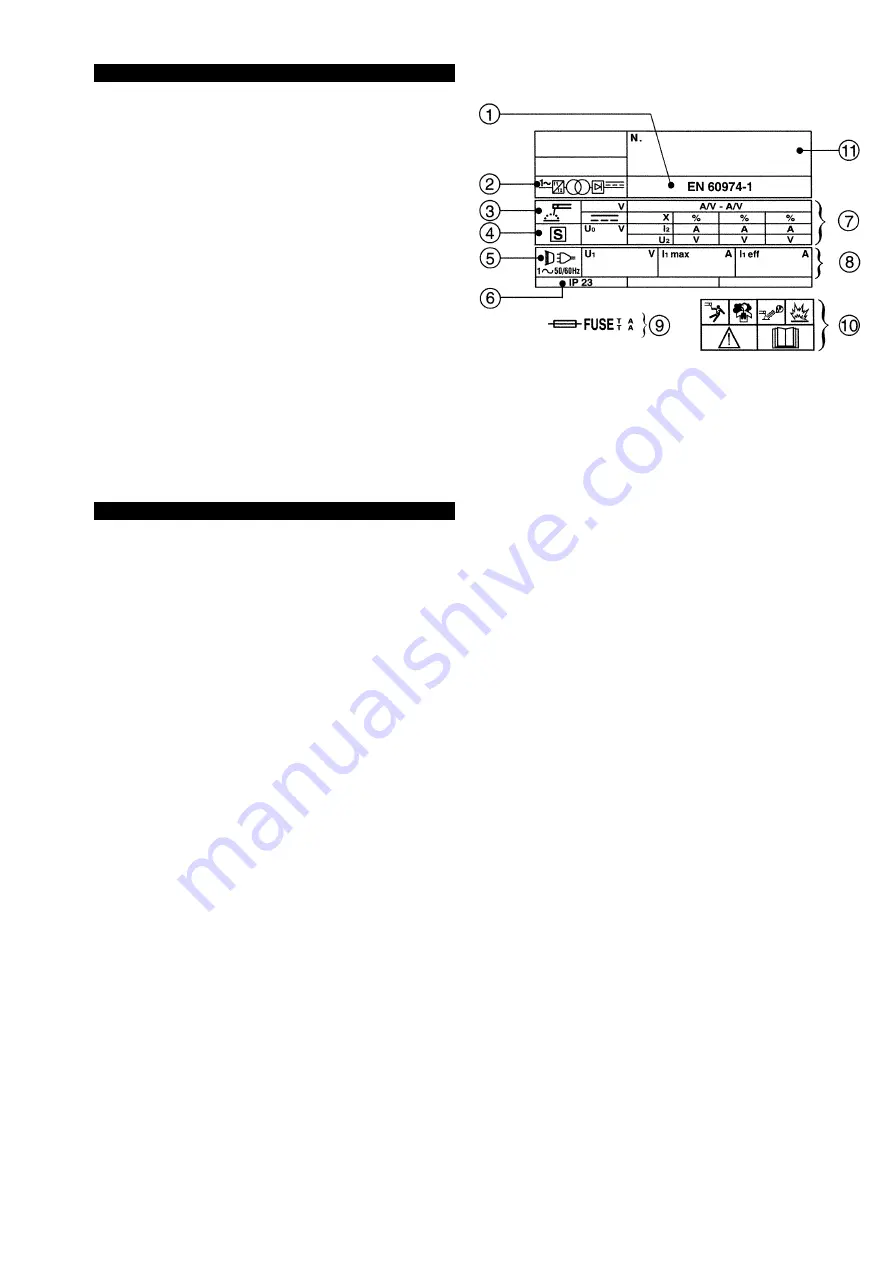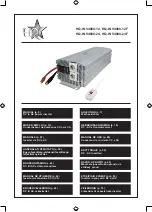
MW140.V2, MW140PLUS, MW150, MW170 - 1 - 110303
8. RATING PLATE
On the rear of the inverter is the rating plate, giving the following data:
1 - The standard relating to the safety and construction of arc welding
and associated equipment.
2 - Inverter-transformer-rectifier.
3 - Welding procedure: manual arc welding with covered electrode.
4 - S: Indicates that welding may be carried out in environments with a
heightened risk of electric shock e.g. very close to large metallic objects.
5 - Power Supply: Single-phase AC.
6 - Rating of internal protection provided by casing.
7 - Output
U
0
: Maximum open-circuit voltage.
I
2
, U
2
: Current and corresponding voltage.
X: Welding ratio based on a 10 minute cycle. 30% indicates 3 minutes
welding and 7 minutes rest, 100% indicates continuous welding.
A/V-A/V: Welding current adjustment range and corresponding voltages.
8 - Power Supply
U
1
: Rated supply voltage and frequency.
I
max
: Maximum current.
I
1eff
: Maximum effective current.
9 - Delayed fuse for supply protection.
10 - Symbols referring to safety.
11 - Serial Number. Specifically identifies each inverter.
9. ELECTROMAGNETIC COMPATIBILITY
9.1. THIS EQUIPMENT IS IN CONFORMITY WITH THE EUROPEAN STANDARD ON THE ELECTROMAGNETIC COMPATIBILITY
OF ARC WELDING EQUIPMENT AND SIMILAR PROCESSES (e.g. ARC AND PLASMA CUTTING)
9.2.
Protection against interference. (E.M.C.)
The emission limits in this standard may not, however, provide full protection against
interference to radio and television reception when the equipment is used closer than 30m to the receiving antenna. In special cases,
when highly susceptible apparatus is being used in close proximity, additional mitigation measures may have to be employed in order
to reduce the electromagnetic emissions. At the same time there could occur some potential difficulties in having electromagnetic
compatibility in a non-industrial environment (e.g. in residential areas). Therefore it is most important that the equipment is used and
installed according to the following instructions.
9.3.
Installation and use.
The user is responsible for installing and using the equipment according to these instructions. If electromagnetic
disturbances are detected, then it shall be the responsibility of the user of the equipment to resolve the situation with the technical
assistance of the supplier. In some cases this remedial action may be as simple as earthing the circuit (see Note). In other cases it
could involve constructing an electromagnetic screen, enclosing the welding power source and the work, complete with associated input
filters. In all cases the electromagnetic disturbances shall be reduced to the point where they are no longer troublesome.
Note:
The welding/cutting circuit may or may not be earthed for safety reasons. Changing the earthing arrangements should only be
authorised by a person who is competent to assess whether the changes will increase the risk of injury, e.g. by allowing parallel
welding/cutting circuit return paths which may damage the earth circuits of other equipment. Further guidance is given in IEC 974-13 Arc
Welding Equipment - Installation and Use.
9.4.
Assessment of area.
Before installing the equipment the user shall make an assessment of potential electromechanical problems in the
surrounding area. The size of the surrounding area to be considered will depend on the structure of the building and other activities that
are taking place. The surrounding area may extend beyond the boundaries of the premises.
The following shall be taken into account :
a) Other supply cables, control cables, signalling and telephone cables, above, below and adjacent to the welding equipment.
b) Radio and television transmitters and receivers.
c) Computer and other control equipment.
d) Safety critical equipment, e.g. security monitoring of industrial equipment.
e) The health of people in the vicinity, e.g. persons fitted with a pacemaker or hearing aid.
f) Equipment used for calibration or measurement.
g) The immunity of other equipment in the environment. The user shall ensure that other equipment being used in the environment is
compatible. This may require additional protective measures.
h) The time of day that welding and other activities are to be carried out.
9.5.
Mains supply.
The equipment should be connected to the mains supply according to these instructions. If interference occurs, it may be
necessary to take additional precautions such as filtering of the mains supply. Consideration should also be given to shielding the supply
cable of permanently installed equipment in metallic conduit or equivalent. This shielding should be connected to the power source so
that good electrical contact is maintained between the conduit and the welding power source enclosure.
9.6.
Maintenance of the equipment.
The equipment should be routinely maintained according to these instructions. All access and service
covers should be closed and properly fastened when the welding equipment is in operation. The welding equipment should not be modified
in any way except for those changes and adjustments covered in these instructions. In particular, the spark gaps of any arc striking and
stabilising devices should be adjusted and maintained according to the instructions.
9.7.
Cables.
The welding/cutting cables should be kept as short as possible and should be positioned close together, running at or close
to the floor level.
9.8.
Equipotential bonding.
Bonding of all metallic components in the welding/cutting installation and adjacent to it should be considered.
However, metallic components bonded to the workpiece will increase the risk that the operator could receive a shock by touching these
metallic components and the electrode at the same time. The operator should be insulated from all such bonded metallic components.
























